IDP News Issue No. 28
- Recent Japanese Research on Silk Road Manuscripts
- The Zhufoyaojijing at the Lüshun Museum
- Database of the Normative Glyphs in Hanzi Script (HNG)
- Codicological study of old Chinese Manuscripts
- Exploiting the high dynamic range of images for study
- Scientific Analysis of Paper from Ancient Central Asian Manuscripts
- The British Library Sanskrit Fragments
- Journals
- Conferences in 2007
- Boris Il'ich Marshak
- Ford Foundation Symposium
- IDP Worldwide News
- IDP UK
Recent Japanese Research on Silk Road Manuscripts
This issue of IDP News is devoted to articles by Dunhuang researchers in Japan, including colleagues at Ryukoku University, site of IDP Japan. This includes a detailed study by Professor Mitani of a manuscript at Lüshun Museum; Professors Ishizuka and Akao give summaries of their own research on the palaeographical and codicological study of the Dunhuang Chinese manuscripts, research which fits in with the current IDP Palaeographic and Codicological Leverhulme research project; Professors Okada, Enami and their colleagues give a taste of some of the scientific and analytical work being carried out at Ryukoku University; Professor Karashima introduces the collaboration with IDP to digitize and catalogue the Sanskrit fragments at the British Library.
The Zhufoyaojijing at the Lüshun Museum
Introduction
The Zhufoyaoji sutra discussed in this paper is the translation of Dharmarakṣa (239–316), who was also referred to as the Dunhuang Bodhisattva or the Yuezhi Bodhisattva. He was a Buddhist monk who, having worked on over 150 juan of sutras, was the most famous Buddhist translator before Kumārajīva.
In the course of the project involving the identification of some twenty thousand Chinese manuscript fragments at the Lüshun Museum, we discovered that one fitted together with the Zhufoyaojijing published as a photographic reproduction in the Saiiki koko zufu 西域考古図譜 (hereafter Zufu). The manuscript published in this volume was excavated at Toyoq and bears a colophon stating that it was copied in AD 296. Therefore, this is the oldest dated Buddhist manuscript written in the Chinese script. (The oldest known secular manuscript is the Li Bo manuscript 李柏尺牘稿 dated AD 328 in the collection of the Academic Information Centre, Ryukoku University.)
The fragment of this manuscript was discovered in the Lüshun Museum collection, among the volumes (‘Blue Notes’) containing the Turfan fragments. In 1992, at the start of the thirteen-year collaboration between Ryukoku University (Rector Ueyama and Professor Emeritus Oda) and Lüshun Museum, this discovery played an important role in securing complete cooperation on the part of the Museum. As part of this, fifty-two volumes of the ‘Blue Notes’ were examined comprising about 26,000 Chinese fragments.
The fragment discovered in the Lüshun Museum collection had the pressmark 20.1456 with the label 経帖七 and was the fifteenth item on page 16. It fitted together with the manuscript published in Zufu. The calligraphic style and the paper quality also corroborated the fact that the two pieces were part of the same manuscript. In the course of the Sino-Japanese joint project aimed at the identification of fragments, we were able to confirm a total of fourteen fragments belonging to the same manuscript.
Unfortunately, the published portion of the manuscript containing the colophon is now lost. It is possible that in the future we will discover items that can be linked with Turfan manuscripts held in other Chinese, German, Russian or British collections and we hope that the fragments we have managed to piece together will become a basis for similar types of research.
It is possible that the Zhufoyaojijing fragments discovered in the course of our project, as well as information obtained from other collections of manuscript fragments, will not only highlight the importance of the Turfan region in the Buddhist translation projects but will also change our understanding of both the history of sutra translations and the development of the Chinese script. In this sense, the two-day International Symposium held in Dalian on October 14-15, 2006 is extremely important. We are very much looking forward to future research in this field.
Provenance
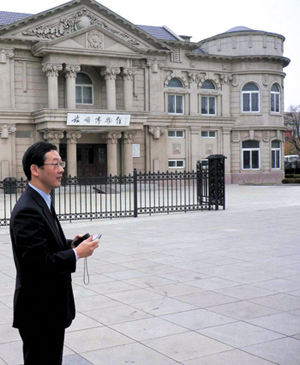
Professor Mitani during a recent visit to the Lüshan Museum.
In 1915, in his Preface to Zufu, Otani Kozui wrote that it was remarkable to have a Buddhist manuscript with a colophon dating it to 296. Comparing the collection with those obtained by explorers from other countries, he pointed out that in terms of the early date and the variety of the material, the academic value of the collection was also significant. Thus the importance of this manuscript for research was clear from the very beginning.
Kanda Kiichiro wrote: ‘The manuscript has a colophon stating that it was copied in the 6th year of the Yuankang reign (AD 296) of the Western Jin dynasty, and there can be no doubt whatsoever that the sutra indeed belongs to that period. Moreover, none of the currently known dated manuscripts, including the Dunhuang manuscripts collected by Stein and Pelliot, nor the Dunhuang manuscripts in the collection of the National Library of China, bears a date earlier than this. In the Stein collection of Dunhuang manuscripts, the earliest is a manuscript of the Shisong biqiu jieben 十誦比丘戒本with a colophon dating to AD 406; in the Pelliot collection, a copy of the Mahāparinirvāṇa Sūtra 大般涅槃經 has a colophon dating to AD 512.’ (p. 242).
In Japan, the earliest dated manuscript is the Biyujing 比喩経 in the collection of the Tokyo Museum of Calligraphy, with a colophon dating it to the 1st year of Ganlu; i.e. the Ganlu reign period of the Former Qin dynasty 359-364), not that of the Wei dynasty (256). The authenticity of the date on the privately owned manuscript of the Tuoluoni shenjing 陀羅尼神経, containing a colophon with a date of 278, is doubtful.
In addition, among the non-Buddhist texts, the Taishang Xuanyuan Daodejing 太上玄元道徳経(colophon dating to 270) introduced by Professor Rao Zongyi 饒宗頤 from Hong Kong University is also doubtful: since it was in Li Shengduo's 李盛鐸 old collection of Dunhuang manuscripts it might be a forgery.
With respect to the time and place of discovery, Kanda states that ‘this manuscript was discovered in Toyoq in the Turfan Basin by Nomura Eizaburo and Tachibana Zuicho during the Second Otani expedition.’ (p. 242).
With respect to the calligraphic style of the manuscript, Naito Konan 内藤湖南 pointed out that ‘this calligraphy lies between the bafen and kai styles, somewhat closer to kai than the so-called clerical (li) style. It is close to the style used on stone inscriptions towards the end of the Latter Han and during the period of the Three Kingdoms, especially to the Jiuzhen Taishou Gulang 九眞太守谷朗碑 stele from the kingdom of Wu. It uses an extremely gracious style of writing in vogue at the time.’ He added that: ‘the calligraphy of the Zhufoyaojijing is in transition from the old clerical towards the kai style, and although the brush strokes still undeniably include traces of the clerical style, it is actually already written in the kai style.’ From this point of view, the manuscript may change our understanding regarding history of the script, especially the birth and development of kai and cao styles.
As for the provenance of the manuscript, Kanda observed that ‘just because the manuscripts were discovered in Turfan, we cannot automatically assume that they were all actually written there.’ And later on, ‘We cannot completely exclude the possibility that the manuscripts were written in the contemporary cultural centres of Luoyang or Chang’an and were transported to such a distant place subsequently. If we consider that the translation project of Dharmarakṣa was carried out in various places along the route from Dunhuang to Hexi, before reaching Chang’an and Luoyang, is not so surprising that the manuscript was circulated in the Turfan region as it was known to be in frequent communication with Dunhuang.’ (p. 246).
In conclusion, he remarks that ‘this is a Chinese manuscript with a definite date, and as such it not only represents the oldest copy of a Buddhist sutra but also brings up a number of important issues regarding the history of Chinese calligraphy.’ (p. 247).
Okabe Kazuo 岡部和雄 (1983) also points out that this is currently the oldest dated Buddhist manuscript (p. 24), then further suggests that ‘although the provenance of the manuscript is unclear, it might come from the Turfan region where it was discovered, or from nearby Dunhuang. Since the Shengdayinjing 聖法印経 was translated in Jiuquan, this manuscript might have also been translated in Jiuquan or Dunhuang.’ (p. 23).
Fragment Details
Below is the date and paper type for the fourteen fragments discovered at the Lüshun Museum. To the right is the reconstruction of the original manuscript, including the portion published formerly in Zufu. Here I rely on the Taishō Tripiṭaka in my attempt to approximate as much as possible the original text of the manuscript. Square parentheses [ ] mark passages taken from the Taishō, and missing or damaged characters are marked by □. The parentheses show text that links to lines with an identifiable borderline, showing its connection with the beginning or end of line. The notes show the differences in comparison with the Taishō text.
| Date: | AA (written in 296) |
| Number of fragments: | 14 (AA) |
| Paper: | Old hemp paper |
| Number of lines: | a total of 31 lines |
| Characters per line: | 15–19 |
| Identified location: | Zhufoyaojijing, vol. 2. (Taisho T.17_0810_0769b23–c29) |
| Fragment numbers: | 1) 493_07_03 2)1458_32_08 3)1464_24_21 4)1466_12_13 4)1455_37_01 5)1452_35_11 6)1452_34_10 7)1455_33_02 8)1455_36_06 9)1450_27_09 10)1460_07_18 11)1450_26_01 12)1464_34_09 13)1456_16_15 |
Right: Calligraphic style of characters on fragments in the Lüshun Museum collection.
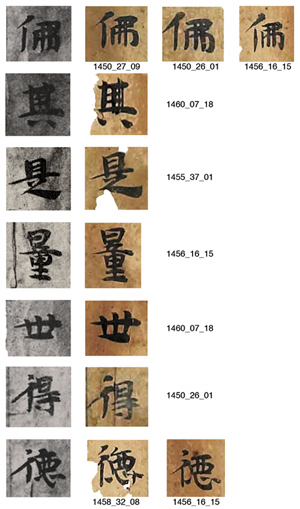
- 01 □□□□□□〕[菩薩]大士。[所]〔得三昧定力聖慧。
- 02 百千億倍無以為〕[喩。]不能[察]〔知棄諸陰蓋菩薩
- 03 之力之所興發。正〕[使十方]〔一切衆生悉得定慧。
- 04 如棄諸陰蓋菩薩聖慧。〕[不]及如[來舉足下足舉]
- 05 動進止之所開化。如來〕[聖]慧不可思誼。巍巍[如]
- 06 是不可攀喩。時佛歎此諸〕佛慧徳。[七]〔萬二千
- 07 人。悉發無上正真道意。異口同音〕[各舉歎]〔曰。令
- 08 我等身逮得聖慧。亦當〕[如斯]
- 09 彼時世尊告善調菩薩。〕是離[意女。]本勸文[殊]
- 10 令發道意。如文殊〕[師]利等。[東]〔方〕[世界]〔如恒
- 11 沙等。南方西方北方四維上〕[下。]〔亦復如是。悉女
- 12 所化。又族姓子。棄諸陰〕[蓋菩]薩大[士。勸離意女]
- 13 使〕[發道意。]八[維]上下各〔恒〕河沙等。亦復如[是。所開]
- 14 〔化 者。〕[如離]意女[等無]〔差〕[特。]今我[於此得成 佛道。]〔亦〕
- 15 〔轉法輪。本因族姓子亦勸化吾使發道意。乃至〕
- 16 〔往久遠過去世時。〕[須]〔彌幡〕[等佛。]在世[教化]〔如〕
- 17 〔我等類。在於〕[十]〔方〕各恒[河沙]如來現在。〔其〕
- 18 〔滅度者不[可]稱限。[皆見開化。這説此語。]〔三〕
- 19 〔千大千世界六反震動。箜篌樂器不鼓〕[自鳴。]〔飛〕
- 20 〔鳥禽獸相〕[向悲鳴。]〔自慶〕鳥獸値佛聖。地[獄餓]
- 21 〔鬼〕[悉得]解脱。心[中悦]豫如冥睹明。[婦女]
- 22 〔珠〕[環相□]作聲。〔當爾之時〕[莫不欣慶。]〔説是〕
- 23 〔法時。普光世〕[界九十二載]諸[天]及人。皆得無
- 24 〔所從〕[生]法忍。於是世界[承]佛威神。悉聞斯[法]咸
- 25 〔共〕[勸助。代]其悦豫欣[慶]無量。[彌]勒菩薩[亦]
- 26 〔受此法。益加恭敬。〕[於斯]〔佛土聞是法者。六〕
- 27 〔十四億諸天及人。皆發無上正真道意。又七〕
- 28 〔萬人。僉復逮得無所從生法忍。萬四千比丘意〕
- 29 〔解漏盡。五百比丘尼心亦解脱。二十六載世間人〕
- 30 〔民。遠塵離垢〕[諸法眼淨]
- 31 〔於是釋〕迦文佛。告彌勒〔菩薩。仁當受此經典之〕
- 32 〔要。於後〕[末世少有]信[者。]〔唯以相付使得廣布。彌〕
- 33 〔勒白佛。唯當受之。如聖所〕[教。不敢違命。]此經典者。
- 34 〔若於後世所流布處。若受〕[持]者徳不可量。若有
- 35 〔菩薩。供養過去諸滅〕度佛。又現十方無[極]〈36 行以図譜掲載写真の釈文〉
- 36 〔聖尊。〕及諸[發意]建志[學道。方當]學者[悉令]
- 37 〔長〕[存。一]切聲聞并與縁覺[及其]菩薩。若有一人。
- 38 〔於〕[當]來世。悉供養此諸如來衆一切施安。過去
- 39 〔當來今〕[現在]佛。等奉無異。[福寧]多不。彌[勒白]
- 40 〔佛。多矣〕[世]尊。吾聞此喩。其心惘然不識所趣。其
- 41 〔數〕[浩]浩不可稱計。福無限量佛言。若有菩薩。
- 42 〔受是經典。持諷誦〕讀。為他人説。得一反聞。而悦
- 43 〔信〕[者。]福多[於彼]供養諸佛。佛語彌勒。我今[現]
- 44 〔在。〕[若滅度]後。假使女人。聞離意女名徳之稱。棄
- 45 〔諸陰〕蓋菩薩之號。天王如來并此經法。因聞斯
- 46 〔經名〕徳變化。竟是一世轉女人身得為男[子。疾]
- 47 〔成無上〕[正]真之道。為最正覺。未成佛頃。世世[所]
- 48 〔生。常〕[値佛世。棄]捐八難諸□不閑。常識宿命。
- 49 〔逮得〕[總]持。三十二相莊嚴其身。所在遊居[不更]
- 50 〔胞胎。常〕得化生。所以者何。諸大正士。威神廣
- 51 〔大〕[不]可稱計。若有女人得聞[其]名。然後亦當
- 52 〔逮〕[得]如此功勳。佛説如是。彌勒[菩薩。諸天]〔人〕
- 53 〔民阿〕須倫聞佛所説。莫不歡喜
- 54 □
- 55 □[康]二年正月[廿]日。月支菩薩法護手執□
- 56 □□授聶承遠和上。弟子沙門竺法首筆
- 57 □□令此經。布流十方。戴□□弘化。速成□□
- 58 □□□□□□□□元康六年三月十八日寫[已]
- 59 □□□□□□□□凡三萬十二章。合一萬九千五百九十六字
Creating a periodization standard
On the basis of the periodization system of Fujieda Akira 藤枝晃 (1987), (2005) and Kudara Kogi 百済康義 (2003), the Society for the Study of Western Regions, Ryukoku University is developing a new standard. The AA standard is based on Professor Fujieda's codicology. In the future, using the available material as a sample, we aim to establish a system applicable for any manuscript, regardless of its provenance.
Besides text identification and calligraphic styles, we are including the form, colour and material of paper, in order to create a dating standard with a higher degree of accuracy.
Apart from the fourteen fragments from the Lüshun Museum, there are many manuscripts from Turfan scattered around the world. Rather than relying solely on the intuition of scholars, we should like to be able to use a digitized standard for evaluation — this would also facilitate stitching fragments together and reconstructing original manuscripts.
Notes on transcription
- 05誼=議
- 10殊師利=文殊
- 13恒河沙=恒沙
- 14如離=者如離
- 17各恒河沙=各恒沙等(等の字見せ消)
- 18可稱=可久稱(久の字見せ消)
- 20値=得値
- 24於(一字挿入)
- 41計=載
- 45法=典
- 53歡喜=歡喜。稽首禮佛。 諸佛要集經卷下
- AA Early Northern dynasties, late 3rd – first half of 5th centuries (until the Northern Liang period)
- A Late Northern dynasties, first half of 5th – mid 6th centuries (until early Gaochang period)
- A' Gaochang kingdom period, first half of 6th – mid 7th centuries (until the destruction of the kingdom of Gaochang)
- C Tang dynasty (7 – 10th centuries)
- C1 End of Gaochang period – Tang dynasty
- C2 Tang dynasty
- C3 Tang dynasty – Uighur period
- D Uighur period (mid 9th – 11th centuries)
NB: C1–C2 are not part of the Fujieda dating system. We are using them for convenience and hope that it will become the standard in future research.
Future Prospects
The group marked as AA is a mixture of a number of different calligraphic styles, and in the future it would be important to construct a manuscript character database enabling us to make a comprehensive analysis of characters for dating calligraphic styles. The most urgent thing to do in order to increase the precision of the periodization standard of the hard-to-date Turfan manuscripts, is to create a sample base of character forms. Furthermore, such a standard could prove useful in establishing the dating standards for other manuscripts scattered around the world.
In addition, I should also like to suggest some additional directions for the future.
- Compare Dharmarakśa's translations of other works beside the Zhufoyaojijing.
- Find the manuscript portion containing the colophon (originally published in Zufu).
- Develop a codicological standard/methodology for the dating of manuscripts.
- Develop a database of manuscript characters.
- Compare with material in other collections.
- Make manuscripts accessible through the internet.
This time everything needed for the project, including computers, personnel and financial support, was made available for us in a speedy manner. We hope that in the future our cooperation will be just as smooth.
In conclusion, I should like to quote Professor Ueyama Daishun, our research representative, who made the following remark at the 100th anniversary of the Otani expeditions: ‘These artefacts are usually thought of as being separated around the world; however, quite to the contrary, they unite people from different countries who are working with them.’
Although the cooperation between Lüshun Museum and Ryukoku University are only concerned with small fragments, they succeed in bringing together Chinese scholars and young Japanese researchers. The identification of the fragments, which was an impossible task at the time when the ‘Blue Notes’ were first assembled, provided an opportunity for many Japanese and Chinese researchers to gain first-hand experience. I am grateful that I could be part of this work.
Again, I am very glad that our cooperation enabled us to transcend the historical issues between China and Japan, and we are likely to expand our cooperation to involve scholars from around the world.
Bibliography
解 題
- 泉芳璟「諸仏要集経解題」『国訳一切経』「経集部十五」大東出版社, 1932, pp.63-65.
- 『仏書解説大辞典 第五巻』大東出版社, 1933 初版, p.277.
- 『大蔵経全解説大事典』雄山閣出版, 1998, p.239.
- 松本文三郎「中央亜細亜發掘の古寫經に就て」『藝文』第2年第2号, 1911.
- 神田喜一郎「中国書道史上より見たる大谷探検隊の将来品について」『西域文化研究 第五』(中央アジア仏教美術)法蔵館, 1962, pp.241-253.
- 岡部和雄「訳経と写経」『東洋学術研究』22-2(特集・仏典漢訳の諸問題)1983, pp.13-47.
- 陳国燦「吐魯番出土的《諸仏要集経》残巻与敦煌高僧竺法護的訳経考略」『敦煌学輯刊』4, 蘭州大學敦煌学輯刊編輯部編, 1983, pp.6-13
- 光川 豊芸「『諸仏要.集経』にみられる文殊菩薩—とくに「有所得」と「女身」に関連して」『龍谷大学論集』437, 1991, pp. 58-83.
Database of the Normative Glyphs in Hanzi Script (HNG)
Over the past twenty years I have been compiling the ‘Ishizuka Register of Chinese Character Standards of Writing’ 石塚漢字字体資料 comprising 400,000 character instances from 69 manuscripts. The aim of the project was to demonstrate that each time period and geographical region (country, state) had its own orthographic standard which differed from that of other time periods and geographical regions. Selecting manuscripts of literary, Buddhist and historical texts written in the standard kaishu 楷書 script from each time period and geographical region, I recorded all examples of Chinese glyphs in a database. In order to demonstrate the existence of a standard for each subset of data, the selection of manuscripts included a number of private documents as well as official documents.
Since the material I have accumulated generally lived up to expectations, we started a project at the Linguistics and Information Studies Department at Hokkaido University to make the material available as an online image database in order to create a resource accessible to the scholarly community. In March 2005, sixteen manuscripts were made accessible. A further sixteen went live in March 2006.
I have selected 3,987 different characters taken from the above manuscripts, amounting to a total of 228,976 character instances, to show that each time period and geographical region had its own orthographic standard which differed from that of other time periods and geographical regions. In addition, I was able to detect differences between standard glyphs used in public and private documents.
The ratio of variant character standards is calculated as the proportion of variant glyphs to the number of written characters, using the following formula:
| Ratio of = variant glyphs |
total no. of variant glyphs ------------ total no. of characters (with more than one variant) |
x 100 |
The ratio of variant glyphs indicates the conscious effort to adhere to a standard, and is thus an important characteristic of the text, revealing whether it was handwritten or printed, official or private, a study book or a copy of a sutra (see Table below).
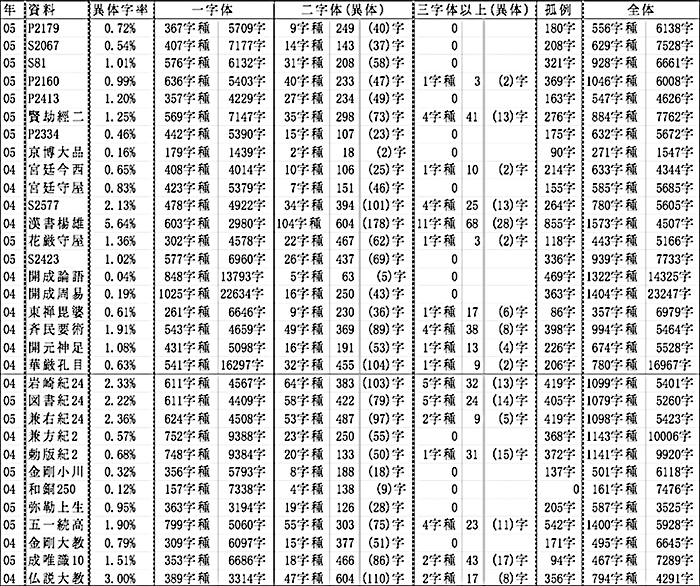
If the ratio of variant glyphs is low, it shows a stronger consciousness with regard to the standard. The early Tang court sutras and the Kaicheng Stone Classics confirm that at that time and place a firm standard was in use. In texts adhering to the standard, the ratio of variant glyphs never goes beyond 1%. Moreover, the variability of character orthography reflects the flexibility of the standard, which in turn is reflected in the rising ratio of variant glyphs. The same sutra could be written with a different degree of consciousness regarding the orthographic standard, depending on whether it was a court sutra (Imanishi and Moriya) or a private copy (Or.8210/S.2577).
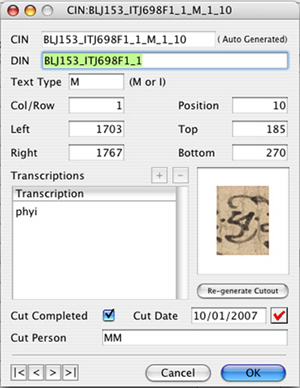
In this paper I have introduced the general structure and search functionality of the database. The material in the database demonstrates that a) there was an early Tang standard; b) a standard was present in the Kaicheng Stone classics, which was different from the early Tang one; c) the relatively fluid Northern Song forms by the Southern Song evolved into the more regulated standard of the Kaicheng Stone Classics; d) early Japanese manuscripts employed the early Tang standard into which they occasionally introduced glyphs from the Kaicheng Stone Classics and the Southern Song printed editions – these became fully adopted by the time of the Keicho Shoki (printed in 1599). Moreover, there was a significant difference in the ratio of variant glyphs between official (manuscripts, stone classics, printed texts) and private (manuscripts, printed texts) domains, clearly revealing that scribes observed the orthographic standard to a different degree depending on the nature of the text.
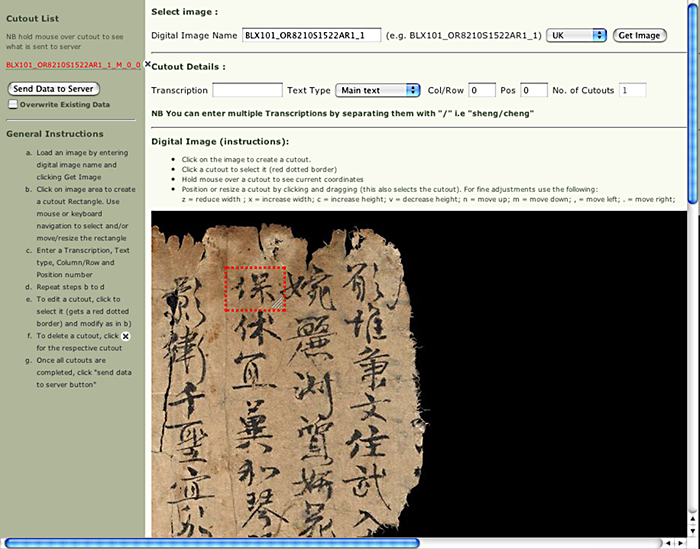 As part of the Leverhulme funded palaeographical research project, IDP has developed a web-based ‘cutting out’ tool (see above). The Chinese characters and Tibetan syllables are stored on the IDP database (see above right). This means that each character is linked to the manuscript on which it appeared and can be looked at alongside
palaeographical and
codicological data.
As part of this project, these tools will be made accessible to all.
As part of the Leverhulme funded palaeographical research project, IDP has developed a web-based ‘cutting out’ tool (see above). The Chinese characters and Tibetan syllables are stored on the IDP database (see above right). This means that each character is linked to the manuscript on which it appeared and can be looked at alongside
palaeographical and
codicological data.
As part of this project, these tools will be made accessible to all.Codicological study of old Chinese Manuscripts
My field of speciality is the codicological study of Buddhist manuscripts written in Chinese script from China, Korea and Japan. As curator at the National Museum, my work includes showing the results of my research at exhibitions organized by the Museum. In autumn 2004, we held a very well received special exhibition entitled ‘The 50th Anniversary of the Donation of the Moriya Collection: Old Manuscripts and the Sanctification of Writing’, in the framework of which we displayed over 160 Chinese manuscripts from China, Korea and Japan.
I have been working on developing a methodology for the study of Buddhist and non-Buddhist manuscripts as material objects, focusing on the evolution of paper texture and character forms. In order to estimate the date of the manuscripts, my research has involved measuring the dimensions of the grid of paper fibre, the panel width and height, lines per panel, and tracking down and evaluating available bibliographic information. In terms of the time span, the studied items range from fifth century Chinese to fifteenth century Japanese manuscripts, roughly encompassing a period of a thousand years.
Since the 1985 publication of the paper entitled ‘The problems of Dunhuang manuscript forgeries in the Moriya Collection of the National Museum of Japan, Kyoto’ by Professor Fujieda Akira, the codicological study of Dunhuang manuscripts became my main research. In 1989, as an overseas researcher sponsored by the Japanese Ministry of Education, I conducted an investigation of the Stein Collection at the British Library and the Pelliot Collection at the Bibliothèque nationale de France. Subsequently, dependent on available research funds, I have been to London and Paris five more times to study Dunhuang manuscripts. Between 30 June–2 July 1997, I presented a paper at a workshop organized by IDP at the British Library under the title ‘Forgeries of Dunhuang Manuscripts in the Early Twentieth Century’. Since then, I have been presenting papers on old manuscripts at international conferences held in Japan, China and Korea.
Parallel with this, I am also involved in other projects, such as the examination of all Buddhist manuscripts in Japan.
Exploiting the high dynamic range of images for study
IDP produces digital images with a high dynamic range and a high resolution but at present the detailed information (e.g. tone, resolution) in these images is not exploited by scholars. It could be used, for example, to form clusters of similar papers and for stroke analysis. The Digital Archives Research Centre of Ryukoku University is currently investigating these two areas as follows:
1. Clustering of paper types of old documents using high dynamic range images
High dynamic range images have high colour depth for each RGB channel. That is, the images have a fine tone resolution for the colours. For the clustering we adopt CIE L*a*b* colour space which linearizes the perceptibility of colour differences instead of RGB colour space. In our proposed clustering technique, the following parameters are also adopted.
- Colour information, that is three real values, L*, a* and b*.
- Degree of the colour distribution complexity for each pixel.
- Region belonging degree for each pixel.
Using the above parameters, we are investigating the possibility of clustering similar papers of old documents.
2. Ink colour adjustment filter for brush stroke analysis
As a brush stroke image contains gradations of ink density, it is necessary to obtain an image with high colour depth for analysis. The current high resolution image has detailed paper surface information (e.g. fibre on the paper), and also captures the shading made by lights and the asperity of a paper. But these are not necessary for stroke analysis. We are therefore investigating an ink colour adjustment image filter which preserves the ink density gradation and reduces factors such as shadow and the paper colours.
Scientific Analysis of Paper from Ancient Central Asian Manuscripts
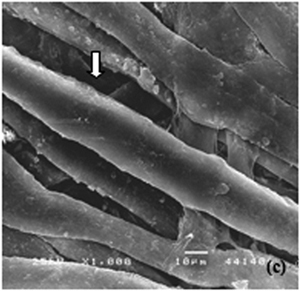 SEM image enlarged 10 times of paper of Or.8210/S.2407 after washing. The morphology is
typical of mulberry fibres.
SEM image enlarged 10 times of paper of Or.8210/S.2407 after washing. The morphology is
typical of mulberry fibres.The Scientific Analysis and Preservation Group of the Digital Archives Research Centre at Ryukoku University carries out analysis of Central Asian manuscripts in the Otani collection using scanning electron microscopy (SEM), X-ray fluorescence (XRF), and a newly designed high-resolution digital microscope. The manuscripts found in Dunhuang and other Central Asian sites are undoubtedly a world treasure from the point of view of their importance for the study of history, Buddhism, religion, culture, and social life of Central Asia. But they are also important as physical objects, for the study of the development of paper and the book. The scientific study of the paper of the Dunhuang and Central Asian manuscripts is therefore no less important than the philological study of the texts. Our group has already studied paper specimens from over a hundred documents including, for example, Uighur documents in the Otani collection, and we have obtained interesting results on their origin. We have also worked on specimens from the Stein collection with the collaboration of the Chinese Section of the British Library and IDP.
The British Library Sanskrit Fragments
Over the past six months over 3,000 digital images of fragmentary Sanskrit manuscripts at the British Library have come online on IDP thanks to the generous support of the International Research Institute for Advanced Buddhology at Soka University, Japan. At the same time, Professor Karashima has been coordinating an international cataloguing effort and the results of this were published in late 2006 in the first issue of a new journal, The British Library Sanskrit Fragments, edited in collaboration with Klaus Wille. Here we reproduce a slightly shortened version of Professor Karashima's postscript to the journal explaining the background to this project.
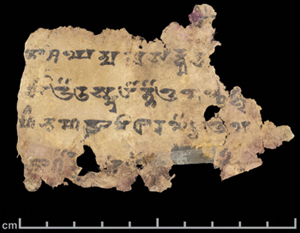 Sanskrit fragment IOL San 454, digitized by IDP and catalogued and transcribed by Professor
Karashima for the IRIAB collaboration.
Sanskrit fragment IOL San 454, digitized by IDP and catalogued and transcribed by Professor
Karashima for the IRIAB collaboration. When I visited the British Library last summer, Ursula Sims-Williams kindly showed me Watanabe's unpublished paper, consisting of 57 pages, entitled 'Preliminary Report of the Studies on Khotan Fragments collected by Dr. Stein and Dr. Hoernle' (cf. p. 23 in the journal), which Hoernle had received in June 1909. In this paper, Watanabe reported his identifications and made comparisons of the fragments with other versions. Many of these identified fragments were edited by Hoernle in his Manuscript Remains, though there are still more than ten texts, which remained unpublished and unknown until quite recently — one of them is the above-mentioned Sarvabuddhaviṣayāvatārajñānālokālaṃkāra (cf. pp. 191ff. in the journal). Judging from its Preface and Acknowledgments, Watanabe must have prepared it for publication. At the sight of this faded report, which is here and there crossed out with red pencil and cut with scissors — most probably done by Hoernle, when he used those parts for the publication of his Manuscript Remains — I was shocked and could hardly hold back my tears, thinking of Watanabe's great achievements and his probable deep disappointment.
After his return to Japan in 1910, Watanabe, who later organised and edited the Taishō Tripiṭaka (1924–34), seems to have spent much more time working for society as a priest and writing essays — both of these activities he was very successful in — as opposed to philological studies of manuscripts. Especially after losing the manuscripts of his studies on the Mahāmāyūrīvidyārājñī and the Adhyardhaśatikā Prajñāpāramitā which were ready for publication together with his library in the Great Kantō Earthquake in 1923, he hardly published any further philological works. This is indeed a great pity as if he had continued studying Sanskrit manuscript fragments from Central Asia in collaboration with Western scholars, we would not have remained at the stage we are at today.
There must be many manuscripts, which remain unpublished, unstudied and are gradually decaying in museums, libraries and in the hands of private collectors and scholars. Here, therefore, I should like to encourage scholars to exchange information more openly and not to retain manuscripts or photos in their desks unstudied for many years. We should emulate the generosity, which Hoernle and Oldenburg showed a century ago.
In this spirit, the International Research Institute for Advanced Buddhology (IRIAB), Soka University, to which I belong, and the BL agreed to digitize the entire collection of the Sanskrit manuscript fragments from Central Asia, consisting of more than 4500 items in all. We have also decided to put these digitized images, along with preliminary identifications, transcriptions and information about the fragments on both the International Dunhuang Project (IDP) Interactive Web Database and the IRIAB website, six months after IRIAB receives them. In this way, we plan to make this invaluable heritage accessible to all scholars and students throughout the entire world. This project — I shall call it BLSF (The British Library Sanskrit Fragments) Project — has been mainly financed by the Open Research Centre Project 2004–2008 — 'Research Centre for Buddhist Philology' by name, based at IRIAB and subsidised by the Ministry of Education, Culture, Sports, Science and Technology, Japan. Mr. Tatsushi Tamai, a Japanese specialist of the Tocharian language, who advised me to undertake this project, has also generously supported this financially. Additional suport is given by the British Library.
In order to carry out the project effectively, I invited any colleagues in Japan and abroad to join the international team, which I set up for this purpose. Many scholars welcomed this project and expressed their willingness to contribute to it. Among them, Dr. Klaus Wille, who has long been working on the Central Asian manuscript fragments, preserved in the BL along with those in Germany and other places in Europe, immediately sent me his transliterations of hundreds of fragments in the Hoernle Collection as well as those of the above-mentioned Sarvabuddhaviṣayāvatārajñānālokālaṃkāra, both of which are published in the present volume. As well as this, he has played an important role as one of the editors-in-chief of this series, by checking transliterations prepared by other contributors.
Apart from inviting experienced experts from abroad, I have started the Brāhmī Club, which convenes every two weeks for the purpose of reading Central Asian Sanskrit fragments together and thus training the younger generation.
This volume is the first fruit of the endeavours of those scholars and students, who sympathise with the ideal of fairness in studying manuscript fragments as well as with the importance of publishing them swiftly. I hope this series, which will cover all the important Sanskrit manuscript fragments in the British Library collections, will become what Watanabe Kaikyoku dreamt of a century ago.
Acknowledgements
I should like to express my heartfelt gratitude to Michael O'Keefe, Susan Whitfield, Ursula Sims-Williams and Sam van Schaik of the British Library, with all of whom I have been discussing the project since 2004, for their readiness to make materials available for our research and showing the same generosity as their predecessor, A. F. R. Hoernle, did one hundred years ago. Sims-Williams also contributed an article concerning Hoernle's achievements to the journal. I should like to extend my gratitude to Lore Sander for her valuable advice on paleographical questions. I am also indebted to all the participants of the Brāhmī Club who read the prepared manuscripts and made a number of useful suggestions. Tatsushi Tamai has contributed much to this project not only financially but also by checking transliterations prepared by others and working on digitized images for publication, as well as contributing an article on the Tocharian fragments. His contribution is greatly appreciated, as are those of Jundō Nagashima, Jirō Hirabayashi, Kōji Matsumoto (all from Taishō University), Noriyuki Kudō, Kenzō Kawasaki, Hayashi Hisako (all of IRIAB), Chou Hsiu-Li, Nobue Hanzawa (both of Soka University), all of whom assisted Tamai during the final stage of preparing the plates. Without their help, the present volume would not have been made available for publication in such a short time. Thanks are due as well to Jan Nattier, Nobue Hanzawa and Peter Lait for correcting my English. I should also like to express my gratitude to Soka University Board of Trustees Chair, Yasunori Tashiro, and IRIAB Director, Hiroshi Kanno, for their encouragement and their generous support for this project. Without the unselfish endeavours and generosity of all these people, this volume could not have been possible.
Journals
SilkRoad Newsletter
Volume 4 Number 1
Summer, 2006
This year Mongolia celebrates the 800th anniversary of the kuriltai which marked the founding of the Mongolian Empire under its leader newly designated as Chingis Khan. Under Chingis and his successors Mongolia in the thirteenth century was for a time indeed at the 'centre of the world.' As students of Inner Asian history know, at several earlier times in its history too, Mongolia had been the centre of nomadic polities which encompassed large portions of Inner Asia and played a major role in the lives of their nomadic and sedentary neighbours. It is appropriate therefore that we devote much of this issue of The Silk Road to Mongolia.
View the SilkRoad Newsletter online.
Steppe
Issue 1, December 2006
The first issue of this magazine devoted to all things Central Asian includes articles on Prokudin-Gorskii's remarkable photographs of the Bukharan Emirate, Rebecca Beardmore on the Kazakh Baths, the 'Pamir Knot: Where Mountains Meet' by Mike Searle, and 'Karakol: A Russian Town in Remotest Central Asia' by Ian MacWilliam, all sumptuously illustrated.
For further details and to subscribe visit the Steppe website
Journal of Inner Asian Art
and Archaeology
Volume 1, 2006
Edited by Dr. Lilla Russell-Smith (London) and Dr. Judith A. Lerner (New York)
Print version only: €50 + shipping
Print and online verion: €55 + shipping
Bulletin of the Asia Institute: 16
December 2006
Containing a broad array of articles and reviews, many on Central Asia.
US$65 plus shipping.
To order contact: Carol Altman Bromberg
Conferences in 2007
The Art of Central Asia and the Indian Sub-continent in
Cross-Cultural Perspective
(1st – 14th centuries A.D.)
12-16 March, 2007
National Museum Institute
New Delhi, India.
The focus of this conference is on The Art of Eastern Central Asia, especially Miran, Khotan, Kucha-Kizil, Turfan and Dunhuang. Papers discussing new research work on sites in West Central Asia would also be welcome.
For details contact:
Professor Anupa Pande
Dept. of History of Art
National Museum Institute
National Museum campus
Janpath, NEW DELHI 110011, India
Phone: +91 11 2301 4476
Email: Professor Anupa Pande
A Hundred Years of Dunhuang 1907-2007
17–19 May, 2007
The British Library and
The British Academy, London, UK
The British Academy in conjunction with The British Museum and The British Library are hosting this three-day international conference. It will be held at the three venues in London, and is organised by Frances Wood, The British Library, and Helen Wang, The British Museum. In this centenary year of Stein’s first visit to Dunhuang the conference will seek to reflect on the cave's discovery in 1900, to review its impact on 'oriental studies' – including the writing and re-writing of history – and to discuss furture directions. The rich finds from Dunhuang have implications beyond 'oriental studies' and need to be understood as part of world culture.
For details see the British Academy website
Exhibition:
Gods, Guardians and Immortals
The British Museum
February-August 2007
An exhibition of religious paintings from China including paintings from Dunhuang.
Public Conservation Lecture
The British Library Conference Centre
21 May, 2007
Held to celebrate the opening of the new British Library Conservation Centre and to coincide with the Seventh IDP Conservation Conference, the lecture will be followed by a reception.
7th IDP Conservation Conference
The Conservation of Dunhuang and Central Asian Collections
21-23 May, 2007
British Library, London, UK
Please note, this is an invitation only conference to conservators. It will consist mainly of workshops and round table sessions.
For details contact: Barbara Borghese
Globalization and Turkic
Civilization
Third International Congress On Turkic Civilization
Kyrgyz-Turkish Manas University
Centre For Turkic Civilization Studies
28-31 May, 2007
Bishkek, Kyrgyz Republic
The Congress aims at gathering together scholars conducting research in this field in order to evaluate past studies and to determine future goals. The Congress will be held at the main campus of Manas University. It is possible for the participants to present their papers in Kyrgyz, Turkish, English or Russian languages. The congress fee (non refundable) is USD60.
For details contact:
Organizing Committee
Kyrgyz-Turkish Manas University
Center for Turkic Civilization Studies
Prospect Mira 56, Bishkek/Kyrgyzstan
Phone/Fax: (+996 312) 55 27 82
Email: turkuygar@manas.kg; ilsahin40@gmail.com; guljanatke@gmail.com
Kazan and the Altaic World
PIAC 50th Meeting
Tatar State University of Humanities and Education, Kazan
1-6 July, 2007
The 50th annual meeting of PIAC is organized under the sponsorship of the Academy of Sciences of the Republic of Tatarstan, the Cabinet of Ministers, the Ministry of Education, and the Town Council of Kazan. The meeting will be held on the premises of the Tatar State University of Humanities and Education, Kazan. At this stage, please do not now send the title of the paper you wish to give, and please do not ask for individual acknowledgements of your request.
For details contact:
The Secretary General, PIAC
Goodbody Hall 157 Indiana University
1011 E. Third St., Bloomington
Indiana 47405-7005, USA
Fax: +1 812-855-7500
Email: sinord@indiana.edu
Boris Il'ich Marshak
Dr. Marshak had been the Head of the Central Asian and Caucasus Section of the Oriental Division of the State Hermitage Museum in St. Petersburg, Russia since 1979. 2006 marked the thirtieth anniversary of his assuming the direction of the important excavations at Panjikent, a Sogdian (Eastern Iranian) site of the 7th–8th centuries where he began his career in archaeology in 1954. In accordance with his will, Dr. Marshak was buried on the territory of the archaeological site to which he devoted his life's work.
Born in Luga, Leningrad District, on 9 July, 1933, Boris Marshak received his initial training in archaeology from Moscow University. In 1965 he defended his dissertation at the Institute of Archaeology of the Soviet Academy of Sciences in Leningrad, on the subject of Sogdian pottery of the 5th–7th centuries, and his second doctorate at Moscow University in 1982 on oriental silverware of the 3rd–11th centuries.
The breadth of his knowledge of the cultural interactions across Central Asia in the first millennium is reflected in his published legacy of more than 100 works, including half a dozen monographs. He was known for his advocacy of a distinct Sogdian culture within the larger world of Iranian culture; he contributed to the understanding of relations between Central Asia and China. His Sogdian Silver (1971) remains the authoritative study of the subject, and his Legends, Tales and Fables in the Art of Sogdiana (2002) offers an evocative interpretation of the striking murals uncovered by the Panjikent expeditions. As he wrote in the conclusion to that publication of the Ehsan Yarshater Lectures he delivered at the University of London, ‘I foresee the criticism that my imagination has been too vivid at times.’
Dr. Marshak was honoured by foreign membership of the Académie des Inscriptions et Belles-Lettres (Institut de France), the Archaeological Institute of America, the Royal Asiatic Society of Great Britain and Ireland and the Instituto Italiano per l'Africa e l'Oriente (Rome). He held numerous visiting professorships and fellowships, among them ones at the University of Vienna, Yale University, the University of Pennsylvania, the Institute for Advanced Study (Princeton), the Metropolitan Museum of Art and the Smithsonian Institution (Arthur Sackler Gallery).
Dr. Marshak is survived by his wife Valentina I. Raspopova, a distinguished archaeologist who worked alongside him at Panjikent.
Ford Foundation Symposium
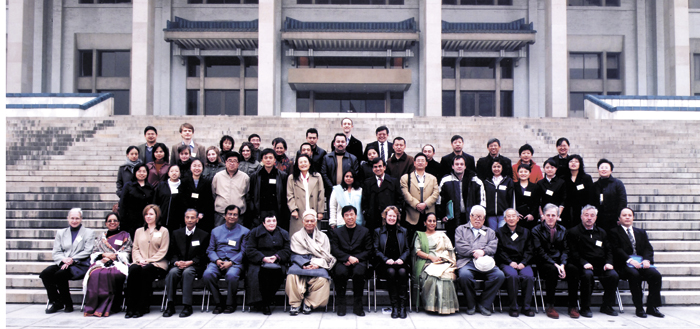
The first symposium held under the project 'Bringing Together Scholars, Scholarship and Scholarly Resources on the Silk Road (China – India – Russia) 2006-2008' sponsored by the Ford Foundation took place on 20th-22nd November, 2006 at the National Library of China (NLC), Beijing. The topic chosen was the versions and transmission in different languages of the Sutra of Golden Light (Suvarṇaprabhāsottamasūtra). The Indian research coordinator, Dr Radha Banerjee of the Indira Gandhi National Centre for the Arts, New Delhi, spent two weeks with IDP at the British Library before the symposium undertaking preliminary research on the Sutra, compiling the home page of the web resource and preparing the bibliography. This web resource was then presented at the symposium to scholars. It was suggested that links to other online resources and papers be included, along with links to images of the texts in all languages in all institutions collaborating with IDP. When finished, the web resource will be translated into Chinese and Russian.
As the research coordinator for China, Dr Saren Gaowa of IDP China at the NLC had organised all the local logistics from invitation letters for the visas of overseas delegates, to accommodation and travel arrangements. She also coordinated a team of colleagues of the Rare Books and Special Collections department at the NLC under Mr Zhang Zhiqing for the hire of the symposium meeting room, refreshments for tea breaks, and specially ordered buffet lunches in the staff canteen to cater for different dietary requirements. The team at IDP China also compiled a web resource on the Sutra in Chinese to complement the English language resource.
The Russian research coordinator, Katia Karmanova, of the Institute of Oriental Studies, St Petersburg arrived in Beijing one week prior to the symposium and spent time at the NLC familiarising herself with the IDP work of conservation, digitization, cataloguing and research. She also helped out with final preparations for the symposium, met the Russian delegates at the airport and was responsible for their well-being during their stay. Radha Banerjee looked after the group of five scholars from India, and accompanied them to other meetings in Beijing.
Six scholars from India, six from Russia and eleven from China presented papers at the symposium, as well as one specialist scholar from the USA, Dr. Natalie Gummer of Beloit College. From China, the scholars presenting papers were mostly from universities in Beijing. In addition there were two papers by colleagues at the NLC and two papers by scholars of the Dunhuang Academy based in Lanzhou. There were also other Chinese scholars and students in attendance, including a large number of research students working on Central Asian topics from the Central University for Nationalities in Beijing. These students were themselves mostly from non-Han Chinese ethnic backgrounds and raised some interesting points in the discussion about interpreting Chinese history from the viewpoint of non-Han ethnicities.
The NLC had published in a welcome booklet the full texts papers with bilingual abstracts in English and Chinese. Other information such as scholars' names and affiliations as well as the full programme of the symposium was included. This provided a very useful reference tool for all and was an excellent aid in the interpretation between Chinese and English after papers had been given and during discussions. After the symposium, scholars will revise their papers and re-submit them for formal publication, supported by Dr Shen Weirong of Renmin University, Beijing. The Rare Books Department exhibited some of the manuscripts of the Sutra held at the NLC.
Ms. Zhao Daying of IDP China did a large amount of the translation for the symposium into both Chinese and English, especially in the context of the discussions.
Papers were presented on the different Central Asian language versions of the Sutra, including Chinese, Tibetan, Mongolian, Khotanese, Uighur, Tangut and Sanskrit. Topics analysed included the concept of kingship in the Sutra with particular relation to Khotan. The depiction of the Sutra in Dunhuang wall paintings was also discussed in a paper. Copies of the Sutra held at the NLC, the IOS and the Nakamura Collection in Tokyo were discussed, as well as newly discovered fragments.
The symposium was enthusiastically received by all delegates present, and it was agreed that it provided an excellent opportunity to meet scholars from the other countries face-to-face in a focused and convivial scholarly setting. Scholars learnt more about the work being done on the Sutra in other countries, as well as the operating cultures of the different scholarly communities. Contacts were made, and ideas for new collaborative projects between scholars working in China and Russia on the Tibetan version of the Sutra were circulated.
IDP Worldwide News
| Items | Images | |
|---|---|---|
| UK | 54,244 | 90,569 |
| China | 9,161 | 11,641 |
| Russia | 746 | 4,905 |
| Japan | 16 | 1,399 |
| Germany | 4,299 | 8,760 |
IDP China
The NLC hosted the first Ford Foundation Project symposium in November (see above) at which time meetings were held to discuss the future direction of IDP China, following the successful completion of the first five-year collaboration. It was agreed to extend the collaboration, expand digitization and research, and to work together on fundraising, education and promotion. An extension to the original completion is currently being drafted.
The Digitization Studio expansion was possible thanks to the generous award of a five-year grant by the Sino-British Fellowship Trust (SBFT) which has already supported IDP's work at the NLC for the past five years, and previously given many other grants to Chinese scholars and conservators. Their support has been invaluable to the success of the collaboration and we are delighted that they will continue to be involved.
The NLC and IDP agreed to work together to hold an exhibition of historical photographs of 'the British in China', mainly from the British Library, at the NLC in autumn 2007, curated by John Falconer.
The NLC is producing a facsimile of the Diamond Sutra in a limited edition in early 2007 and IDP will provide images. IDP has plans to produce further facsimiles in the future.
IDP Russia
The Mellon-funded project was extended to April 2007 to allow completion of 6,000 images. The team in Russia has now completed almost 5,000.
It is planned to finish inputting Menshikov's catalogues in 2007 and, funding permitting, to continue work on Chinese material while also extending the remit to include the Tangut material.
The Institute of Oriental Studies will host the second Ford Foundation symposium in April 2007.

IDP Japan
The team in Japan has been working hard at digitizing the manuscripts in the Omiya Library Collection and over one thousand images are now online. Many of the fragments are very small, as can be seen from the photograph (right), which shows the IDP Japan photographer, Ohgi Akira, preparing a fragment for digitization.
In addition, staff at Ryukoku University are carrying out an extensive programme of research, as can be seen from the papers on pp.1–6 of this newsletter. Further collaborative projects with IDP are planned for 2007.
IDP Germany
Work on digitization was delayed temporarily owing to the digitizer leaving in the autumn but Anja Klier was appointed as a replacement and started work in November. In December, Abby Baker of IDP UK visited Berlin to assist with digitization and carry out further training. Germany has now completed basic manipulation of almost 10,000 images: around 4,000 images of 1800 Chinese fragments are available online.
Barbara Meisterernst continues work on inputting catalogues and, to date, the following are available via the Show Catalogues page: Kudara 2005; Nishiwaki 2001, Thilo 1975 and Thilo 1985. The catalogue of the Tibetan fragments compiled by Manfred Taube in 1980 (Berliner Turfantexte 10) is in preparation.
New publication:
Mitteliranische Handschriften. Teil 1: Berliner Turfanfragmente manichäischen Inhalts.
Beschrieben von Christiane Reck.
Stuttgart, 2006.
ISBN 3-515-02441-7
EUR72.00
http://www.bbaw.de/bbaw/Forschung/Forschungsprojekte/turfanforschung/de/Aktuelles
Dunhuang, China
An agreement between the Dunhuang Academy and IDP at the British Library was signed in autumn 2006 for digitizing the manuscripts in the DHA and other IDP work. In January 2007 staff from the DHA went to Beijing for training at the National Library of China. An IDP Centre will be established at the DHA in early 2007 and data will be input on the manuscripts at the DHA.
Alastair Morrison visited the DHA with a delegation from the Ford Foundation in September and discussed possible further collaboration.
IDP UK
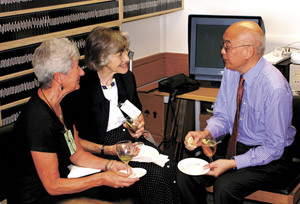 Anne Ely (SBFT), Pamela Youde and Abraham Lue (IDP Patrons) at a Patron's lunch and IDP Studio Open Day in July 2006.
Anne Ely (SBFT), Pamela Youde and Abraham Lue (IDP Patrons) at a Patron's lunch and IDP Studio Open Day in July 2006.People
Thanks to our volunteers who have been doing wonderful work over the past few months. Maude Croucher, based in Beijing, is helping out at IDP China; Beth Kennedy and Stephanie Heaton are both working in London. We really appreciate their support, skills and enthusiasm.
Congratulations to Abby Baker who was accepted to study for an MA in Museum and Galleries in Education at the Institute of Education, University of London. She started in October 2006 and we are looking forward to her input on IDP’s educational programme.
Imre Galambos spent three months in Japan in late 2006 carrying out research for the palaeographical project, giving papers and building links. He also visited the Lüshun Museum with Professor Mitani (below).
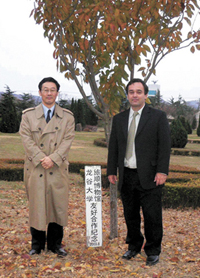
In October a group of European teachers from the Comenius Eurasia programme visited IDP for an 'Inspiration Day'. The programme aims to increase understanding among European schools about the influence of the Silk Road and to foster cultural links. The visiting teachers worked with the artist Ming Wong and explored an educational website developed for the day by Vic Swift, Abby Baker and Alastair Morrison of IDP.
The catalogue of the Tibetan Tantric manuscripts, prepared by Sam van Schaik and Jacob Dalton, was published by E. J. Brill in the Tibetan Studies Library Series Tibetan Tantric Manuscripts from Dunhuang: A Descriptive Catalogue of the Stein Collection at the British Library.
China Central Television (CCTV) are currently filming a nine-part documentary on Dunhuang and asked Susan Whitfield to act as consultant. She met the Chief Director and several of the junior directors during a visit to China in November, and was interviewed for three episodes. The last episode will concentrate on collaborations on Dunhuang material and IDP will feature prominently. The production team will film the training of new digitization staff at IDP China and also hope to come to Europe for filming.
Professor Zhao Feng, Vice-Director of the Hangzhou Silk Museum spent several months based at the British Museum carrying out research on Dunhuang textiles for a forthcoming publication. During this time he analysed the textiles among the Stein collection at the British Library, mainly comprising silk scroll braids and other fragmentary pieces. He also looked at the large collection of Stein textiles at the Victoria and Albert Museum.
Funding Update
The Sino-British Fellowship Trust (SBFT), long-term supporters of IDP, committed to a grant for another five years to cover salaries of four digitization studio staff in China. Anne Ely visited IDP in July (see above) to discuss the proposal. Work has already started on this programme.
The American Trust for the British Library (ATBL) approved a grant for IDP to build links with colleagues in the US and to carry out some digitization of Silk Road manuscript material. An IDP team will visit the US in 2007 for this work and full details will be given in the next issue.
The Chiang Ching-Kuo Foundation for International Scholarly Exchange awarded IDP a grant for the May 2007 7th IDP Conservation Conference (see conferences).
A new section giving details of major grant givers to IDP has been put on the website. Individuals and other donors continue to be listed via the supporters page.
We have received a good response to our Online Silk Road Quest Appeal and thanks to all of you who have sent donations. Our traveller is in the Pamir Mountains and still has some way to go before he gets to Chang'an — by which destination we will have raised sufficient funds to put this interactive educational resource online.
We are now starting a major drive to digitize the Buddhist manuscripts in the collections and should be grateful if you could pass on details of our Sponsor a Sutra scheme to all your friends. A leaflet is available from Sarah Biggs or you can choose your sutra and pay online.
We continue to look for major core funding: if you have any suggestions or would like to learn more about some exciting funding possibilities please contact Sarah Biggs. (Tel: +44 (0)20 7412 7822)

